How the Italian "caimans Piave" beat the Austrians
According to the plan of the Austro-Hungarian General Staff, the offensive was to repeat the success of the actions of the German troops on the Western Front in the spring of 1918. However, unlike last year's battle of Caporetto, this time the Austrians failed to achieve great success. The Italians put up such stubborn resistance (those who resisted the attack even got the nickname “Caiman Piave” for their bravery) that the Austrian command 23 on June gave the order to withdraw to the previous positions. This was the last offensive of the Austro-Hungarian army, it could no longer advance.
prehistory
The 1918 campaign of the year, despite the autumn defeat of 1917, began relatively well for Italy. The Austrians were stopped on a new line of defense in the area of Altipiani - Grappa, along the lower course of the r. Pyava. The whole country, the people again became imbued with the spirit of patriotism and supported the army. The activities of restoring the lost reserves and replenishing the new military warehouses began. Government and industry have focused their efforts on this matter. The firm Ansaldo produced superplanes, which made it possible to restore the loss of artillery after Caporetto. As a result, a mass of weapons, ammunition, equipment and various materials flowed to the front in a powerful stream. The number of enterprises working for the front in 1918 increased to 3700 with the total number of workers in 800 thousand and with a capital of 2 billion lire. By the end of February, the army had 5282 guns and 6500 airplanes; enterprises produced 1700 trucks monthly.
Numerous civilian committees were created throughout the country that made life easier for soldiers: they collected medicines, tobacco, chocolate, soap, clothes, books, etc. for them; the soldiers were entertained, theatrical performances and concerts were organized for various parts, and famous Italian artists took part in it, etc. The authorities conducted active patriotic propaganda. On the other hand, the Austro-German troops in the occupied Italian areas behaved extremely cruel. The refugees who managed to escape and cross the Piave told horrible stories about the behavior of the invaders, robberies, requisitions, senseless destruction, violence against women, etc. This rallied society and the army in the fight against the invaders.
Italians quickly restored the previously broken and upset parts. Near Piacenza, the new 5 Army of General Capello was formed. The demoralized caporetta catastrophe troops were quickly restored, re-equipped, improved and sent to the front. The restored 2 Army in the spring was sent to the Montello area and then transformed into the 8 Army. The Italian army was now strengthened by the Allied divisions. The first British and French divisions arrived at the front as early as December 1917 of the year: French 31 Corps, British 14 Corps. As a result, the Italian army was reinforced by 6 by the French and 5 by the British divisions. But by June 1918 of the year, due to the decisive offensive of the German army on the Western Front, the 2 British and 3 French divisions were recalled. In addition, the Czech division appeared in the Italian army, and then the Romanian division.
The bloody lessons of Caporetto took into account. Instead of concentrating large forces on the front line of defense, where they suffered heavy losses even during the absence of large operations, and were subjected to enormous damage during an enemy strike, they adopted a system of troop separation into depth, bringing small units to the front line to create a thin curtain connections to the second line. In addition, measures were taken to secure the flanks and fill the breakthroughs if the enemy breaks through the front. The new Italian commander Armando Diaz was more intelligent than its predecessor.
After Caporetto, there was a lull at the front. Winter ruled out the possibility of major operations. Therefore, in the winter, there were no significant operations on the land front. In the spring, small groups conducted reconnaissance in mountainous areas, but without much success. When Germany launched the strategic Spring Offensive in France, Italy was even able to send an auxiliary corps to the French Theater. In May, Italians conducted several small successful operations. Aviation Both sides showed activity, Austrian and Italian planes bombed cities, enemy positions, warehouses. Also conducted reconnaissance flights with the aim of photographing enemy positions, studying the movement of troops and to adjust artillery fire. It used to be that Italian pilots landed on enemy territory behind the front line, stayed there for several days, collecting information. Then the pilots walked back, sailing at night through Piave.
The Italian fleet dominated the sea. There were no major operations at sea, as the Austrians remained in their ports. At the same time, the Italians disturbed the enemy for a time, landing naval units at the mouth of the Piave and other places. Italian destroyers, submarines and torpedo boats made raids. Just before the start of the battle, the Italians achieved important success at sea. On June 10, captain-lieutenant Luigi Ritz torpedoed a torpedo boat from one of the most powerful ships of the Austro-Hungarian fleet Saint Istvan. Of the 1094 crew, 89 drowned along with the dreadnought, the rest were able to be picked up by escort ships. This prevented the Italians from attacking the Otrant Barrier that crossed the Adriatic. Admiral Horthy outlined this operation as a run-up to a ground battle. This event had a great resonance in Austria-Hungary and made a depressing impression.
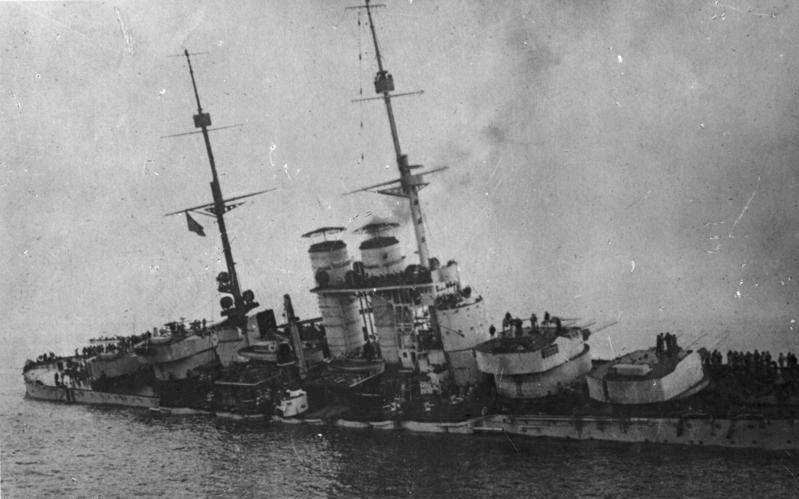
"Saint-Istvan" is sinking. A shot from the newsreel
Preparation of the operation
In the spring of 1918, German troops launched a decisive offensive on the French front. Germany demanded from its ally Austria-Hungary to launch a major offensive in Italy in order to inflict a decisive defeat on the Italians, which allowed the German army in France to strengthen the Austro-Hungarian divisions and divert American troops. The Germans harshly criticized the Austrians for their inaction when Germany bore the burden of war. The presence in France of the Italian corps was a challenge for Austria-Hungary, in which all the combat-ready forces were chained to the Italian front. German Kaiser Wilhelm telegraphed the Austrian Emperor Carl: "Our task is to attack on all fronts." The German General Kramon in Baden pressed on the Austrian high command, extolling the victories of the German army in France and demanding a decisive operation in Italy. Thus was born the idea of the June offensive of the Austrian army.
The Allied Commander Marshal Foch, after the German breakthrough on the Western Front, also demanded that the Italians launch a decisive offensive. Diaz has prepared a plan for the Italian offensive. However, Italian intelligence became aware of the enemy’s plans, including the date and direction of the strikes, so the offensive was postponed. All attention was paid to strengthening the defense.
The Austrians themselves were also inclined to the idea of a new decisive blow in Italy. Only a great military victory could save the Habsburg monarchy from a military-political collapse. The victory at Caporetto gave some moral and economic effect, although Italy was not able to enter from the war, as planned. The Austrians could not rationally use the captured Italian areas, the occupying troops looted and destroyed what they could not take out. In addition, the Austro-Hungarian command still underestimated the enemy. It was believed that the Italian troops are morally inferior to the Austrian, that the Austrian artillery is stronger and the Italians will not withstand the strong onslaught. Austrian field marshal Konrad believed that the position of Italy was like a shipwrecked sailor clinging to a log with his hands, and if he chopped off his fingers with an ax, he would inevitably plunge into the depths of the sea. The German divisions participating in the defeat at Caporetto were recalled, but the Austro-Hungarian army still maintained its combat capability, despite the critical internal position of the empire.
On May 12, at a meeting in Spa, the Austro-Hungarian High Command made the final decision on the operation. According to Conrad's plan, the army was supposed to strike at both sides of Brent in order to enter the r. Buckilone. At the same time, demonstrative attacks were to be made through Piave. However, the commanders offered their plans. Boroevich, commander of the Izontsky army, proposed that the main attack be inflicted on Piave, and not an auxiliary operation. The headquarters of Archduke Joseph, commander of the 6 Army against Montello, adhered to the idea that first you need to cover the right flank of the Izon army and take Montello. And General Waldstetten suggested attacking the Tonale Pass to get an opportunity to break into the valley of Lombardy. As a result, the Austrian high command united three plans into one and decided to conduct two main offensive operations: one in the Grappa area — Brent, the other on Piave. Moreover, before these two operations, an auxiliary at the Tonale Pass should have followed. This led to the advance of two army groups in divergent directions and the deterioration of operations management.
Behind the Grappa-Piave line there were no serious natural obstacles, the Italian army was underestimated, so the Austrian command as a whole was confident of a decisive victory. General Arts wrote to Hindenburg: "I am convinced that as a result of our offensive, which should lead us to the Adige, we will achieve a military defeat of Italy." The Austrian General Staff believed that a major military victory would save the empire, would allow to capture more booty, especially food, on the rich plains of Northern Italy. The Austrian command hoped that the Italians would not withstand a strong blow on a broad front, their reserves would be insufficient, and their resistance would collapse, and the further the Austrian divisions would advance, the easier and more decisive the victory would be. The soldiers were promised more booty in the form of food, industrial goods, leather, and soap for them personally and their families. The motive for the troops was the need to alleviate the food crisis in Austria-Hungary. In order to prevent the predatory destruction of trophies, as it was after Caporetto, special trophy teams were created under the command of experienced officers who were to collect, preserve and distribute the captured good.
The forces of the parties
The Austrians had 60 divisions larger than the Italian, 7500 guns, 580 aircraft. The offensive was to take part 50 divisions - 27 in the mountainous region and 23 in the plain. The commander in chief was the Archduke Eugene and his troops were divided into two groups. The Tyrolean (Western) Field Marshal Group Conrad - 10-I and 11-I army. Piave Group (Eastern Group) of Field Marshal Boroevich - 6-i and Izontskaya army.
The Italian army had 56 divisions (including three British, two French and one Czechoslovak divisions), 7043 field and 523 anti-aircraft guns, 2046 mortars, 676 airplanes, 4 airship}. In the upcoming Austrian offensive, 44 Italian divisions were located, of which 19 divisions comprised a mobile reserve provided by 1800 trucks, which had 539 light and 28 heavy weapons, 228 mortars. 12 divisions were in general reserve. On the left flank were the 7-I and 1-I armies (total 12 divisions); in the center - 6-I army (total 16 divisions); on the right flank, along the lower course of Piave, are the 8-I and 3-I armies (13 divisions). The Italian army, in well-trained positions, having strong reserves and abundantly supplied with supplies, was quietly waiting for the Austrian offensive.
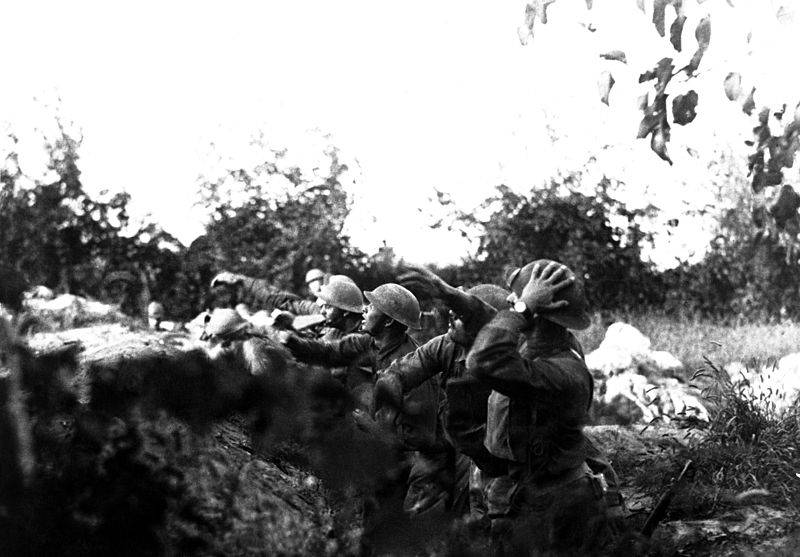
American soldiers at the Battle of Piav
Battle
13 June 1918, the Austrians launched a relief operation in the Tonale area, but it did not lead to success. Early in the morning of 15 on June 1918, after short, but exceptionally strong artillery preparation, which began at three o'clock, the Austrians launched an offensive on the front from the r. Astiko to the sea. Despite the strong fire of the Austrian artillery, the Italians successfully and strongly responded, which unpleasantly surprised the enemy. A large number of Austrian guns were put out of action, and a number of areas where Austro-Hungarian forces were concentrated were so heavily fired that the communication and movement of reserves was disturbed.
Initially, the Austrians were successful and in some places wedged a bit into the location of the Italian army, but were subsequently knocked out by Italian counterattacks. Only in the area of the mountain ridge Montello and in the lower reaches of the river. Piave Austrians captured and retained the bridgeheads, but their expansion was beyond their power because of the strong resistance of the Italians. Thus, the Austro-Hungarian Amia could not create operational mites in the Montello area and on the lower course of Piave. All attempts to establish a connection between the two main areas of the operation and to expand the captured bridgeheads were unsuccessful.
Italians fought bravely. So, during the battle, the nickname “Caiman Piave” (Italian: Caimani del Piave) was earned by the fighters of the arditi strike units (Italian: arditi - brave, brave men) for their insane bravery. Arditi assault units were the first to break into enemy trenches and destroy enemy firing points. The artillery stormtroopers were armed with grenades, daggers, and sometimes carbines, and officers and non-commissioned officers — pistols and revolvers. Ardito relied metal bib with shoulder pads and a helmet of a special sample without fields. The dagger was for the attackers not only a melee weapon, but also a symbol of belonging to the military elite. The motto is: “either we will win, or we will all die” (“O la vittoria, o tutti accopati”). In particular, the assault swimmers Captain Remo Pontecorvo Bacci only in one of the sorties lost 50 from 82 people.
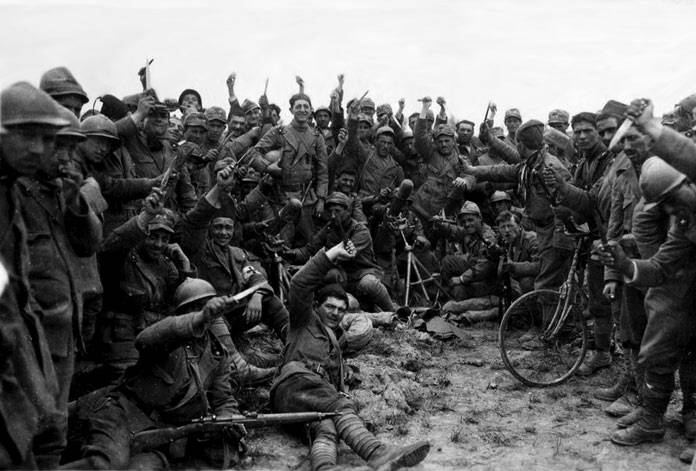
Soldiers units Arditi with daggers. 1918 year.
June 15 Austrian offensive lost its initial pace and was reduced to an attempt to slowly pushing the enemy. It became obvious that further operation was meaningless and would only lead to unnecessary losses. Boroevich, who had previously emphasized the superiority of the Austrian troops, now declared that “the immediate continuation of operations against Treviso would be highly unreasonable in view of the numerical superiority of the opponents. Currently, neither I nor my army commanders have any reserves. In addition, we have a lack of medium-caliber artillery, shells and bridges, ... ”
The Austrians could not expand the bridgeheads, stumbled upon the strong resistance of the enemy. The Italian artillery with its fire on the crossings prevented the passage of Austrian reinforcements to the right bank, and also delivered strong blows at the enemy troops crowded in a limited area of bridgeheads. 16 June Italian troops launched strong counterattacks and recaptured some of the lost space. The bridges thrown across the river 20 were not enough to supply the troops with everything necessary to continue the offensive. In addition, on the night of June 18, the river rose to 80 cm and almost all the bridges were demolished.
June 18 Austrians have moved forward, but the Italians successfully counterattacked and repulsed lost ground. The two Austrian groups that crossed the Piave were finally cut off from each other, surrounded on three sides, having a wide and fast river in the rear. Piave rose even more, and communication with the left bank became even more difficult. 19 Jun Boroevich reported to the emperor that the situation could be saved only by sending fresh troops, shells and food. However, the Austrian commander-in-chief, Arts von Straussenburg, said he could not provide support. The persistent battles continued all day, the pressure of the Italians intensified, the Austrians suffered huge losses.
20 June Boroevich, due to the fact that the 11-I army in Tyrol did not succeed, and his troops achieved only small results, which does not give hope for a successful continuation of the offensive, and there is a threat of complete disaster due to the increasing pressure of the Italians and the rise water on Piave, offered to withdraw the troops back. On the same day, the Italians launched a counter-offensive. The fierce battle lasted all day without any decisive results, and many positions passed from hand to hand several times. 21 - June 22 positional battles continued.
A Russian military historian, General A. Zayonchkovsky, wrote about the Battle of Piav: “After 20 June, heavy rains started, which damaged the Austrian crossings, and the 23-th Austrians decided to start a withdrawal to the left bank of the river, which turned into a catastrophe. Pursued by Italian counterattacks, artillery fire and a raid of a whole mass of allied airplanes, the 5-I Austrian army was rejected behind Piave with the loss of 20 prisoners and 000 guns to 60. It was the swan song of the Austro-Hungarian army, which finally lost its combat capability here and after, until the end of the war, experienced a slow agony of decomposition. "
Thus, the mistakes of the Austrian command, the crowding of the Austro-Hungarian troops on the limited size of bridgeheads, the lack of reserves, difficulties with the supply through the river swelled by the flood and the strong counter-attacks of the Italians in the following days localized the first Austrian successes on Piave. The position of the Austrian troops deteriorated. On the night of June 23, Austrian troops received an order to withdraw to their original positions after Piave. After a series of fierce fights 23 - 24 June, the entire right bank of the Piave was in the hands of the Italians. However, the Italian command was unable to organize the pursuit of the retreating Austrians and the immediate strong counteroffensive during and after the withdrawal of the enemy. Italian troops also suffered heavy losses and were exhausted by fierce battles. And the Austrian positions on the left bank of the Piave were almost completely intact, and the Italian command had no fresh parts for an immediate offensive.
As a result, the advance of the Austrians in June turned out to be completely fruitless. The Italians were ready for an enemy strike and repelled it. The situation on the Italian front stabilized again. The Italian army lost up to 80 thousand people, the Austrians - about 175 thousand people. The failure of the Austrian offensive had serious moral and military consequences. Italy won and became a serious threat to Austria. The Italian army immediately began to prepare for a decisive offensive and conducted a series of successful local operations. Austria-Hungary was defeated, which further demoralized the army and society. The Habsburg Empire failed to support Germany during the decisive offensive in France (Hindenburg hoped that Austria would send its divisions to the French front after Piave).
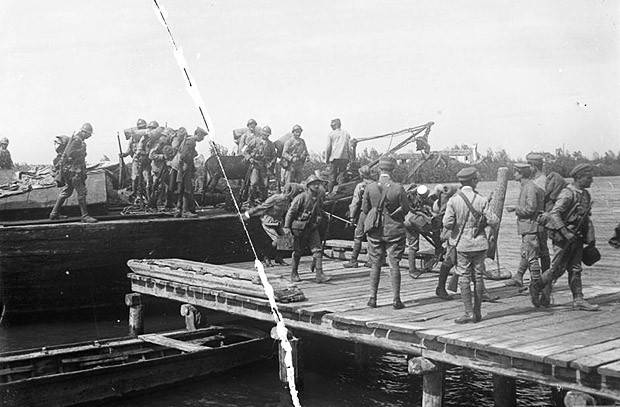
Italian marines make landing from barges during the battle of the river Piave. June 1918 of the year
- Alexander Samsonov
- 1918 Campaign
US world domination strategy
Turkish invasion of Transcaucasia. “Thousands of Russians were shot and burned alive. Armenians are subjected to indescribable torture”
Romanian invasion of Bessarabia
How Romanian executioners exterminated Russian soldiers
German "fist strike" for the purpose of occupation of the western part of Russia
How the Germans occupied the western part of Russia
100 years "lousy" Brest world
100 years of the Baltic Fleet Ice Campaign
Spring Offensive of the German Army
"We will break the gap, the rest will be by itself"
Pyrrhic victory of the German army
Battle on Fox
German divisions in 56 kilometers from Paris
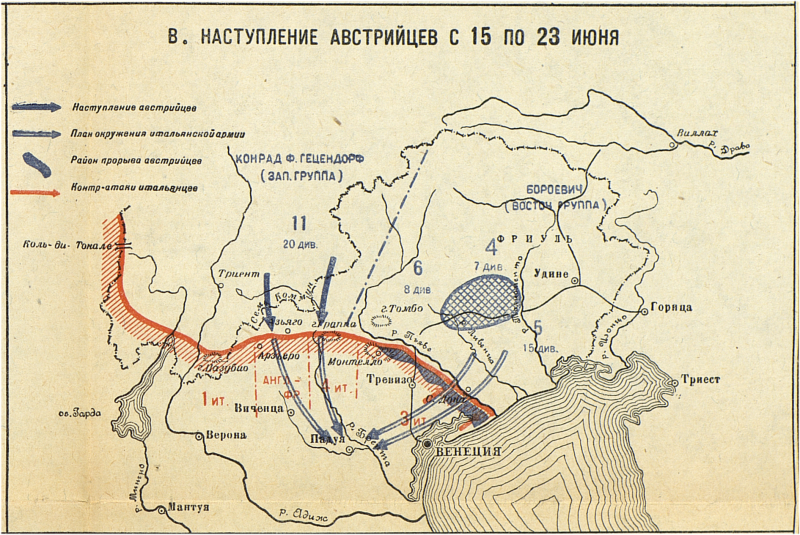
Information